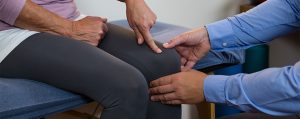Spring Into Better Health: 3 Ways to Improve Your Wellness This Season
Posted on by Kathleen Habschmidt PT, DPT
Spring offers a fresh start — not just for nature, but for your health, too. It’s the perfect time to shake off the cold-weather slump and reset your wellness routine. Whether you’re looking to boost your energy, improve your fitness, or just feel better overall, here are three practical ways to spring into better health this season.
(more…)
Rise and Shine: Try This Morning Routine for an Extra Boost of Energy
Posted on by Teddy Azar, DPT
Are you tired of dragging yourself out of bed every morning, feeling sluggish, and lacking the energy to conquer the day? Well, fret not! As a physical therapist, I'm here to share a refreshing and invigorating morning exercise routine that will jumpstart your energy levels. So, let's dive right into it!
(more…)
Shoulder Stability for Cheerleaders
Posted on by Tara Hackney, PT, DPT, OCS, KTTP
Co-author: Megan Partain, SPT
Have you ever wondered how your favorite cheerleaders spend hours tumbling, stunting, and holding each other up in the air? Well, in cheerleading, it comes down to a little more than just sheer talent but incredibly strong and stable shoulders. Athletes with decreased shoulder strength are prone to injuries like dislocations, sprains, and strains. Current research suggests that regular shoulder strengthening exercises can help prevent these types of injuries. The following exercises are recommended for tumblers and especially indicated for main and instep bases, as well as back spots.
(more…)
Struggling to Sleep? 5 Ways to Catch Better Zzz’s
Posted on by Tony Matoska, PT, DPT, CMPT
Sleep is important, but it isn’t always easy to get. According to the CDC, almost 15% of people have trouble falling asleep most nights. The American Academy of Sleep Medicine and the Sleep Research Society recommend adults sleep a minimum of 7 hours per night. Unfortunately, 25% of adults do not meet this recommendation. Poor sleep habits can cause numerous problems and can slow your body’s ability to heal, impact your ability to maintain or lose weight, negatively affect your mental health, and make you more prone to developing chronic pain. Data also shows that roughly 88% of people with chronic pain report consistent problems sleeping. Fortunately, there are numerous things we can do to improve our sleep, which can even help relieve your pain! If you consistently have problems sleeping and want more energy to help with your pain, these five helpful tips can help you catch Zzz’s and improve your sleep hygiene.
(more…)
5 Restorative Poses to Help Tight Hip Flexors
Posted on by Brandon Jones, PTA, BS, MBPR
Do you ever stand up and ask yourself, “Why are my hips so tight?” There are many reasons, but one may be that, on average, we sit around for 10-14 hours per day, and those muscles are being overused. Today, we will review some restorative poses that could help you with the tightness in your hips. These restorative poses use props such as blankets, bolsters, yoga blocks, and more to help your body feel supported and relaxed. The goal is not to stretch the muscles but to relax the body and mind.
(more…)
Avoiding Wrist Pain and Injuries in Gymnastics
Posted on by Janet Apgar, OTR/L, CHT, CMTPT/DN, AIB-VRC, ASTYM-cert
Gymnastics, the sport most watched in the Summer Olympics, engages viewers because of the extreme strength, balance, agility, accuracy, and endurance required to compete. Years of training tax the gymnast's body to the utmost because movement refinement through repetition exposes the gymnast to many repetitive stress and traumatic injuries. While gymnasts range from the 5-year-old tumbler to the elite Olympian, a unique factor for this sport, no matter the level, is the requirement of using arms for weight bearing. Such compressive and twisting forces affect the entire arm, especially the wrist. Approximately 88% of gymnasts reportedly experience wrist pain according to one study.
(more…)
Spring Into Action: Pre-Season Triathlon Threshold Testing
Posted on by Melissa S. Walker, MPT, CLT
The idea of summer events may seem far away, but race day will be here before you know it. Now is the time to evaluate your fitness level and plan for the upcoming race season. Here are some ideas on how to determine your baseline fitness and how to build your spring training.
(more…)
At-Home Workout Perfect For “You” Time
Posted on by Brandon Bowers, PT, DPT, Astym Cert.
Life gets busy, and sometimes, making time for yourself can be difficult. Fitting in a quick workout can be challenging with limited time and energy. No need to fret, though, because you can build strength and endurance right from the comfort of your home with just a few basic movements. No fancy equipment or expensive gym membership required—just 20 minutes a few times a week, and you will be on your road to a better, healthier you. Let’s take a look at these great exercises.
(more…)
